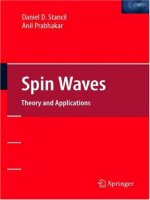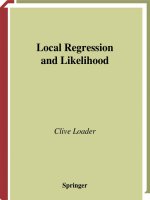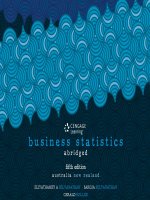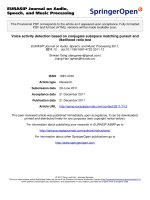Regression and likelihood (springer.1999)(305s)
Bạn đang xem bản rút gọn của tài liệu. Xem và tải ngay bản đầy đủ của tài liệu tại đây (1.37 MB, 305 trang )
Local Regression
and Likelihood
Clive Loader
SpringerPreface
This book, and the associated software, have grown out of the author’s
work in the field of local regression over the past several years. The book is
designed to be useful for both theoretical work and in applications. Most
chapters contain distinct sections introducing methodology, computing and
practice, and theoretical results. The methodological and practice sections
should be accessible to readers with a sound background in statistical meth-
ods and in particular regression, for example at the level of Draper and
Smith (1981). The theoretical sections require a greater understanding of
calculus, matrix algebra and real analysis, generally at the level found in
advanced undergraduate courses. Applications are given from a wide vari-
ety of fields, ranging from actuarial science to sports.
The extent, and relevance, of early work in smoothing is not widely appre-
ciated, even within the research community. Chapter 1 attempts to redress
the problem. Many ideas that are central to modern work on smoothing:
local polynomials, the bias-variance trade-off, equivalent kernels, likelihood
models and optimality results can be found in literature dating to the late
nineteenth and early twentieth centuries.
The core methodology of this book appears in Chapters 2 through 5.
These chapters introduce the local regression method in univariate and
multivariate settings, and extensions to local likelihood and density estima-
tion. Basic theoretical results and diagnostic tools such as cross validation
are introduced along the way. Examples illustrate the implementation of
the methods using the locfit software.
The remaining chapters discuss a variety of applications and advanced
topics: classification, survival data, bandwidth selection issues, computa-
vi
tion and asymptotic theory. Largely, these chapters are independent of each
other, so the reader can pick those of most interest.
Most chapters include a short set of exercises. These include theoretical
results; details of proofs; extensions of the methodology; some data analysis
examples and a few research problems. But the real test for the methods is
whether they provide useful answers in applications. The best exercise for
every chapter is to find datasets of interest, and try the methods out!
The literature on mathematical aspects of smoothing is extensive, and
coverage is necessarily selective. I attempt to present results that are of
most direct practical relevance. For example, theoretical motivation for
standard error approximations and confidence bands is important; the
reader should eventually want to know precisely what the error estimates
represent, rather than simply asuming software reports the right answers
(this applies to any model and software; not just local regression and loc-
fit!). On the other hand, asymptotic methods for boundary correction re-
ceive no coverage, since local regression provides a simpler, more intuitive
and more general approach to achieve the same result.
Along with the theory, we also attempt to introduce understanding of the
results, along with their relevance. Examples of this include the discussion
of non-identifiability of derivatives (Section 6.1) and the problem of bias
estimation for confidence bands and bandwidth selectors (Chapters 9 and
10).
Software
Local fitting should provide a practical tool to help analyse data. This re-
quires software, and an integral part of this book is locfit.Thiscanbe
run either as a library within R, S and S-Plus, or as a stand-alone appli-
cation. Versions of the software for both Windows and UNIX systems can
be downloaded from the locfit web page,
/>Installation instructions for current versions of locfit and S-Plus are pro-
vided in the appendices; updates for future versions of S-Plus will be posted
on the web pages.
The examples in this book use locfit in S (or S-Plus), which will be
of use to many readers given the widespread availability of S within the
statistics community. For readers without access to S, the recommended
alternative is to use locfit with the R language, which is freely available
and has a syntax very similar to S. There is also a stand-alone version,
c-locfit, with its own interface and data management facilities. The in-
terface allows access to almost all the facilities of locfit’s S interface, and
a few additional features. An on-line example facility allows the user to
obtain c-locfit code for most of the examples in this book.
vii
It should also be noted this book is not an introduction to S. The reader
using locfit with S should already be familiar with S fundamentals, such
as reading and manipulating data and initializing graphics devices. Books
such as Krause and Olson (1997), Spector (1994) and Venables and Ripley
(1997) cover this material, and much more.
Acknowledgements
Acknowledgements are many. Foremost, Bill Cleveland introduced me to
the field of local fitting, and his influence will be seen in numerous places.
Vladimir Katkovnik is thanked for helpful ideas and suggestions, and for
providing a copy of his 1985 book.
locfit has been distributed, in various forms, over the internet for sev-
eral years, and feedback from numerous users has resulted in significant
improvements. Kurt Hornik, David James, Brian Ripley, Dan Serachitopol
and others have ported locfit to various operating systems and versions
of R and S-Plus.
This book was used as the basis for a graduate course at Rutgers Uni-
versity in Spring 1998, and I thank Yehuda Vardi for the opportunity to
teach the course, as well as the students for not complaining too loudly
about the drafts inflicted upon them.
Of course, writing this book and software required a flawlessly working
computer system, and my system administrator Daisy Nguyen recieves the
highest marks in this respect!
Many of my programming sources also deserve mention. Horspool (1986)
has been my usual reference for C programming. John Chambers provided
S, and patiently handled my bug reports (which usually turned out as
locfit bugs; not S!). Curtin University is an excellent online source for X
programming ( />This page intentionally left blank
Contents
1 The Origins of Local Regression 1
1.1 The Problem of Graduation 1
1.1.1 Graduation Using Summation Formulae 2
1.1.2 The Bias-Variance Trade-Off 7
1.2 Local Polynomial Fitting 7
1.2.1 Optimal Weights 8
1.3 Smoothing of Time Series 10
1.4 Modern Local Regression 11
1.5 Exercises 12
2 Local Regression Methods 15
2.1 The Local Regression Estimate 15
2.1.1 Interpreting the Local Regression Estimate 18
2.1.2 Multivariate Local Regression 19
2.2 The Components of Local Regression 20
2.2.1 Bandwidth 20
2.2.2 Local Polynomial Degree 22
2.2.3 The Weight Function 23
2.2.4 The Fitting Criterion 24
2.3 Diagnostics and Goodness of Fit 24
2.3.1 Residuals 25
2.3.2 Influence, Variance and Degrees of Freedom 27
2.3.3 Confidence Intervals 29
2.4 Model Comparison and Selection 30
x Contents
2.4.1 Prediction and Cross Validation 30
2.4.2 Estimation Error and CP 31
2.4.3 Cross Validation Plots 32
2.5 Linear Estimation 33
2.5.1 Influence, Variance and Degrees of Freedom 36
2.5.2 Bias 37
2.6 Asymptotic Approximations 38
2.7 Exercises 42
3 Fitting with locfit 45
3.1 Local Regression with locfit 46
3.2 Customizing the Local Fit 47
3.3 The Computational Model 48
3.4 Diagnostics 49
3.4.1 Residuals 49
3.4.2 Cross Validation 49
3.5 Multivariate Fitting and Visualization 51
3.5.1 Additive Models 53
3.5.2 Conditionally Parametric Models 55
3.6 Exercises 57
4 Local Likelihood Estimation 59
4.1 The Local Likelihood Model 59
4.2 Local Likelihood with locfit 62
4.3 Diagnostics for Local Likelihood 66
4.3.1 Deviance 66
4.3.2 Residuals for Local Likelihood 67
4.3.3 Cross Validation and AIC 68
4.3.4 Overdispersion 70
4.4 Theory for Local Likelihood Estimation 72
4.4.1 Why Maximize the Local Likelihood? 72
4.4.2 Local Likelihood Equations 72
4.4.3 Bias, Variance and Influence 74
4.5 Exercises 76
5 Density Estimation 79
5.1 Local Likelihood Density Estimation 79
5.1.1 Higher Order Kernels 81
5.1.2 Poisson Process Rate Estimation 82
5.1.3 Discrete Data 82
5.2 Density Estimation in locfit 83
5.2.1 Multivariate Density Examples 86
5.3 Diagnostics for Density Estimation 87
5.3.1 Residuals for Density Estimation 88
5.3.2 Influence, Cross Validation and AIC 90
Contents xi
5.3.3 Squared Error Methods 92
5.3.4 Implementation 93
5.4 Some Theory for Density Estimation 95
5.4.1 Motivation for the Likelihood 95
5.4.2 Existence and Uniqueness 96
5.4.3 Asymptotic Representation 97
5.5 Exercises 98
6 Flexible Local Regression 101
6.1 Derivative Estimation 101
6.1.1 Identifiability and Derivative Estimation 102
6.1.2 Local Slope Estimation in locfit 104
6.2 Angular and Periodic Data 105
6.3 One-Sided Smoothing 110
6.4 Robust Smoothing 113
6.4.1 Choice of Robustness Criterion 114
6.4.2 Choice of Scale Estimate 115
6.4.3 locfit Implementation 115
6.5 Exercises 116
7 Survival and Failure Time Analysis 119
7.1 Hazard Rate Estimation 120
7.1.1 Censored Survival Data 120
7.1.2 The Local Likelihood Model 121
7.1.3 Hazard Rate Estimation in locfit 122
7.1.4 Covariates 123
7.2 Censored Regression 124
7.2.1 Transformations and Estimates 126
7.2.2 Nonparametric Transformations 127
7.3 Censored Local Likelihood 129
7.3.1 Censored Local Likelihood in locfit 131
7.4 Exercises 135
8 Discrimination and Classification 139
8.1 Discriminant Analysis 140
8.2 Classification with locfit 141
8.2.1 Logistic Regression 142
8.2.2 Density Estimation 143
8.3 Model Selection for Classification 145
8.4 Multiple Classes 148
8.5 More on Misclassification Rates 152
8.5.1 Pointwise Misclassification 153
8.5.2 Global Misclassification 154
8.6 Exercises 156
xii Contents
9 Variance Estimation and Goodness of Fit 159
9.1 Variance Estimation 159
9.1.1 Other Variance Estimates 161
9.1.2 Nonhomogeneous Variance 162
9.1.3 Goodness of Fit Testing 165
9.2 Interval Estimation 167
9.2.1 Pointwise Confidence Intervals 167
9.2.2 Simultaneous Confidence Bands 168
9.2.3 Likelihood Models 171
9.2.4 Maximal Deviation Tests 172
9.3 Exercises 174
10 Bandwidth Selection 177
10.1 Approaches to Bandwidth Selection 178
10.1.1 Classical Approaches 178
10.1.2 Plug-In Approaches 179
10.2 Application of the Bandwidth Selectors 182
10.2.1 Old Faithful 183
10.2.2 The Claw Density 186
10.2.3 Australian Institute of Sport Dataset 189
10.3 Conclusions and Further Reading 191
10.4 Exercises 193
11 Adaptive Parameter Choice 195
11.1 Local Goodness of Fit 196
11.1.1 Local CP 196
11.1.2 Local Cross Validation 198
11.1.3 Intersection of Confidence Intervals 199
11.1.4 Local Likelihood 199
11.2 Fitting Locally Adaptive Models 200
11.3 Exercises 207
12 Computational Methods 209
12.1 Local Fitting at a Point 209
12.2 Evaluation Structures 211
12.2.1 Growing Adaptive Trees 212
12.2.2 Interpolation Methods 215
12.2.3 Evaluation Structures in locfit 217
12.3 Influence and Variance Functions 218
12.4 Density Estimation 219
12.5 Exercises 220
13 Optimizing Local Regression 223
13.1 Optimal Rates of Convergence 223
13.2 Optimal Constants 227
Contents xiii
13.3 Minimax Local Regression 230
13.3.1 Implementation 232
13.4 Design Adaptation and Model Indexing 234
13.5 Exercises 236
A Installing locfit in R, S and S-Plus 239
A.1 Installation, S-Plus for Windows 239
A.2 Installation, S-Plus 3, UNIX 240
A.3 Installation, S-Plus 5.0 241
A.4 Installing in R 242
B Additional Features: locfit in S 243
B.1 Prediction 243
B.2 Calling locfit() 244
B.2.1 Extracting from a Fit 244
B.2.2 Iterative Use of locfit() 245
B.3 Arithmetic Operators and Math Functions 247
B.4 Trellis Tricks 248
C c-locfit 251
C.1 Installation 251
C.1.1 Windows 95, 98 and NT 251
C.1.2 UNIX 251
C.2 Using c-locfit 252
C.2.1 Data in c-locfit 253
C.3 Fitting with c-locfit 255
C.4 Prediction 256
C.5 Some additional commands 256
DPlotsfromc-locfit 257
D.1 The plotdata Command 258
D.2 The plotfit Command 258
D.3 Other Plot Options 261
References 263
Index 285
This page intentionally left blank
1
The Origins of Local Regression
The problem of smoothing sequences of observations is important in many
branches of science. In this chapter the smoothing problem is introduced
by reviewing early work, leading up to the development of local regression
methods.
Early works using local polynomials include an Italian meteorologist
Schiaparelli (1866), an American mathematician De Forest (1873) and a
Danish actuary Gram (1879) (Gram is most famous for developing the
Gram-Schmidt procedure for orthogonalizing vectors). The contributions
of these authors are reviewed by Seal (1981), Stigler (1978) and Hoem
(1983) respectively.
This chapter reviews development of smoothing methods and local re-
gression in actuarial science in the late nineteenth and early twentieth
centuries. While some of the ideas had earlier precedents, the actuarial
literature is notable both for the extensive development and widespread
application of procedures. The work also forms a nice foundation for this
book; many of the ideas are used repeatedly in later chapters.
1.1 The Problem of Graduation
Figure 1.1 displays a dataset taken from Spencer (1904). The dataset con-
sists of human mortality rates; the x-axis represents the age and the y-axis
the mortality rate. Such data would be used by a life insurance company
to determine premiums.
2 1. The Origins of Local Regression
o
o
o
o
o
o
o
o
o
o
o
o
o
o
o
o
o
o
o
o
o
o
o
o
o
o
Age (Years)
Mortality Rate
20 25 30 35 40 45
0.004 0.008
FIGURE 1.1. Mortality rates and a least squares fit.
Not surprisingly, the plot shows the mortality rate increases with age,
although some noise is present. To remove noise, a straight line can be
fitted by least squares regression. This captures the main increasing trend
of the data.
However, the least squares line is not a perfect fit. In particular, nearly
all the data points between ages 25 and 40 lie below the line. If the straight
line is to set premiums, this age group would be overcharged, effectively
subsidizing other age groups. While the difference is small, it could be
quite significant when taken over a large number of potential customers. A
competing company that recognizes the subsidy could profit by targeting
the 25 to 40 age group with lower premiums and ignoring other age groups.
We need a more sophisticated fit than a straight line. Since the causes of
human mortality are quite complex, it is difficult to derive on theoretical
grounds a reasonable model for the curve. Instead, the data should guide
the form of the fit. This leads to the problem of graduation:
1
adjust the
mortality rates in Figure 1.1 so that the graduated values of the series
capture all the main trends in the data, but without the random noise.
1.1.1 Graduation Using Summation Formulae
Summation formulae are used to provide graduated values in terms of sim-
ple arithmetic operations, such as moving averages. One such rule is given
by Spencer (1904):
1
Sheppard (1914a) reports “I use the word (graduation) under protest”.
1.1 The Problem of Graduation 3
1. Perform a 5-point moving sum of the series, weighting the observa-
tions using the vector (−3, 3, 4, 3, −3).
2. On the resulting series, perform three unweighted moving sums, of
length 5, 4 and 4 respectively.
3. Divide the result by 320.
This rule is known as Spencer’s 15-point rule, since (as will be shown
later) the graduated value ˆy
j
depends on the sequence of 15 observations
y
j−7
, ,y
j+7
. A compact notation is
ˆy
j
=
S
5,4,4
5 ·4 ·4 · 4
(−3y
j−2
+3y
j−1
+4y
j
+3y
j+1
− 3y
j+2
) . (1.1)
Rules such as this can be computed by a sequence of straightforward arith-
metic operations. In fact, the first weighted sum was split into several steps
by Spencer, since
−3y
j−2
+3y
j−1
+4y
j
+3y
j+1
− 3y
j+2
= y
j
+3((y
j−1
+ y
j
+ y
j+1
) −(y
j−2
+ y
j+2
)) .
In its raw form, Spencer’s rule has a boundary problem: Graduated values
are not provided for the first seven and last seven points in the series.
The usual solution to this boundary problem in the early literature was
to perform some ad hoc extrapolations of the series. For the moment, we
adopt the simplest possibility, replicating the first and last values to an
additional seven observations.
An application of Spencer’s 15-point rule to the mortality data is shown
in Figure 1.2. This fit appears much better than the least squares fit in
Figure 1.1; the overestimation in the middle years has largely disappeared.
Moreover, roughness apparent in the raw data has been smoothed out and
the fitted curve is monotone increasing.
On the other hand, the graduation in Figure 1.2 shows some amount of
noise, in the form of wiggles that are probably more attributable to random
variation than real features. This suggests using a graduation rule that does
more smoothing. A 21-point graduation rule, also due to Spencer, is
ˆy
j
=
S
7,5,5
350
(−y
j−3
+ y
j−1
+2y
j
+ y
j+1
− y
j+3
) .
Applying this rule to the mortality data produces the fit in the bottom
panel of Figure 1.2. Increasing the amount of smoothing largely smooths
out the spurious wiggles, although the weakness of the simplistic treatment
of boundaries begins to show on the right.
What are some properties of these graduation rules? Graduation rules
were commonly expressed using the difference operator:
∇y
i
= y
i+1/2
− y
i−1/2
.
4 1. The Origins of Local Regression
0.004
0.006
0.008
0.010
21-point rule
20 25 30 35 40 45
0.004
0.006
0.008
0.010
15-point rule
Age (Years)
Mortality Rate
FIGURE 1.2. Mortality rates graduated by Spencer’s 15-point rule (top) and
21-point rule (bottom).
The ±1/2 in the subscripts is for symmetry; if y
i
is defined for integers
i,then∇y
i
is defined on the half-integers i =1.5, 2.5, The second
differences are
∇
2
y
i
= ∇(∇y
i
)
= ∇y
i+1/2
−∇y
i−1/2
=(y
i+1
− y
i
) −(y
i
− y
i−1
)
= y
i+1
− 2y
i
+ y
i−1
.
1.1 The Problem of Graduation 5
Linear operators, such as a moving average, can be written in terms of
the difference operator. The 3-point moving average is
y
i−1
+ y
i
+ y
i+1
3
= y
i
+
1
3
(y
i−1
− 2y
i
+ y
i+1
)
= y
i
+
1
3
∇
2
y
i
.
Similarly, the 5-point moving average is
y
i−2
+ y
i−1
+ y
i
+ y
i+1
+ y
i+2
5
= y
i
+ ∇
2
y
i
+
1
5
∇
4
y
i
.
A similar form for the general k-point moving average is given by the
following result.
Theorem 1.1 The k-point moving average has the representation
S
k
k
y
i
=
I +
k
2
− 1
24
∇
2
+
(k
2
− 1)(k
2
− 9)
1920
∇
4
+ O(∇
6
)
y
i
. (1.2)
Proof: We derive the ∇
2
term for k odd. The proof is completed in
Exercise 1.1.
One can formally construct the series expansion (and hence conclude
existence of an expansion like (1.2)) by beginning with an O(∇
k−1
)term
and working backwards.
To explicitly derive the ∇
2
term, let y
i
= i
2
/2, so that ∇
2
y
i
=1,and
all higher order differences are 0. In this case, the first two terms of (1.2)
must be exact. At i = 0, the moving average for y
i
= i
2
/2is
S
k
k
y
0
=
1
k
(k−1)/2
j=−(k−1)/2
j
2
2
=
k
2
− 1
24
= y
0
+
k
2
− 1
24
∇
2
y
0
.
✷
Using the result of Theorem 1.1, Spencer’s rules can be written in terms
of the difference operator. First, note the initial step of the 15-point rule is
−3y
j−2
+3y
j−1
+4y
j
+3y
j+1
− 3y
j+2
=4y
j
− 9∇
2
y
j
− 3∇
4
y
j
=4(I −
9
4
∇
2
+ O(∇
4
))y
j
.
Since this step is followed by the three moving averages, the 15-point rule
has the representation, up to O(∇
4
y
j
),
ˆy
j
=(I +
5
2
− 1
24
∇
2
)(I +
4
2
− 1
24
∇
2
)(I +
4
2
− 1
24
∇
2
)(I −
9
4
∇
2
)y
j
+ O(∇
4
y
j
).
(1.3)
6 1. The Origins of Local Regression
Expanding this further yields
ˆy
j
= y
j
+ O(∇
4
y
j
). (1.4)
In particular, the second difference term, ∇
2
y
i
, vanishes. This implies that
Spencer’s rule has a cubic reproduction property: since ∇
4
y
j
=0when
y
j
is a cubic polynomial, ˆy
j
= y
j
. This has important consequences; in
particular, the rule will tend to faithfully reproduce peaks and troughs in
the data. Here, we are temporarily ignoring the boundary problem.
An alternative way to see the cubic reproducing property of Spencer’s
formulae is through the weight diagram. An expansion of (1.1) gives the
explicit representation
ˆy
j
=
1
320
(−3y
j−7
− 6y
j−6
− 5y
j−5
+3y
j−4
+21y
j−3
+46y
j−2
+67y
j−1
+74y
j
+67y
y+1
+46y
j+2
+21y
j+3
+3y
j+4
− 5y
j+5
− 6y
j−6
− 3y
j−7
).
The weight diagram is the coefficient vector
1
320
( −3 −6 −5321466774
67 46 21 3 −5 −6 −3). (1.5)
Let {l
k
; k = −7, ,7} be the components of the weight diagram, so ˆy
j
=
7
k=−7
l
k
y
j+k
. Then one can verify
7
k=−7
l
k
=1
7
k=−7
kl
k
=0
7
k=−7
k
2
l
k
=0
7
k=−7
k
3
l
k
=0. (1.6)
Suppose for some j and coefficients a, b, c, d the data satisfy y
j+k
= a+bk +
ck
2
+ dk
3
for |k|≤7. That is, the data lie exactly on a cubic polynomial.
Then
ˆy
j
=
7
k=−7
l
k
y
j+k
= a
7
k=−7
l
k
+ b
7
k=−7
kl
k
+ c
7
k=−7
k
2
l
k
+ d
7
k=−7
k
3
l
k
= a.
That is, ˆy
j
= a = y
j
.
1.2 Local Polynomial Fitting 7
1.1.2 The Bias-Variance Trade-Off
Graduation rules with long weight diagrams result in a smoother graduated
series than rules with short weight diagrams. For example, in Figure 1.2, the
21-point rule produces a smoother series than the 15-point rule. To provide
guidance in choosing a graduation rule, we want a simple mathematical
characterization of this property.
The observations y
j
can be decomposed into two parts: y
j
= µ
j
+
j
,
where (Henderson and Sheppard 1919) µ
j
is “the true value of the function
which would be arrived at with sufficiently broad experience” and
j
is “the
error or departure from that value”. A graduation rule can be written
ˆy
j
=
l
k
y
j+k
=
l
k
µ
j+k
+
l
k
j+k
.
Ideally, the graduation should reproduce the systematic component as
closely as possible (so
l
k
µ
j+k
≈ µ
j
) and remove as much of the error
term (
l
k
j+k
≈ 0) as possible.
For simplicity, suppose the errors
j+k
all have the same probable error,
or variance, σ
2
, and are uncorrelated. The probable error of the graduated
values is σ
2
l
2
k
.Thevariance reducing factor
l
2
k
measures reduction
in probable error for the graduation rule. For Spencer’s 15-point rule, the
variance reducing factor is 0.1926. For the 21-point rule, the error reduction
is 0.1432. In general, longer graduation rules have smaller variance reducing
factors.
The systematic error µ
j
−
l
k
µ
j+k
cannot be characterized without
knowing µ. But for cubic reproducing rules and sufficiently nice µ,the
dominant term of the systematic error arises from the O(∇
4
y
j
)termin
(1.4). This can be found explicitly, either by continuing the expansion (1.3),
or graduating y
j
= j
4
/24 (Exercise 1.2). For the 15-point rule, ˆy
j
= y
j
−
3.8625∇
4
y
j
+O(∇
6
y
j
). For the 21-point rule, ˆy
j
= y
j
−12.6∇
4
y
j
+O(∇
6
y
j
).
In general, shorter graduation rules have smaller systematic error.
Clearly, choosing the length of a graduation rule, or bandwidth,involvesa
compromise between systematic error and random error. Largely, the choice
can be guided by graphical techniques and knowledge of the problem at
hand. For example, we expect mortality rates, such as those in Figure 1.1, to
be a monotone increasing function of age. If the results of a graduation were
not monotone, one would try a longer graduation rule. On the other hand
if the graduation shows systematic error, with several successive points lie
on one side of the fitted curve, this indicates that a shorter graduation rule
is needed.
1.2 Local Polynomial Fitting
The summation formulae are motivated by their cubic reproduction prop-
erty and the simple sequence of arithmetic operations required for their
8 1. The Origins of Local Regression
computation. But Henderson (1916) took a different approach. Define a
sequence of non-negative weights {w
k
}, and solve the system of equations
w
k
(a + bk + ck
2
+ dk
3
)=
w
k
y
j+k
kw
k
(a + bk + ck
2
+ dk
3
)=
kw
k
y
j+k
k
2
w
k
(a + bk + ck
2
+ dk
3
)=
k
2
w
k
y
j+k
k
3
w
k
(a + bk + ck
2
+ dk
3
)=
k
3
w
k
y
j+k
(1.7)
for the unknown coefficients a, b, c, d. Thus, a cubic polynomial is fitted to
the data, locally within a neighborhood of y
j
. The graduated value ˆy
j
is
then the coefficient a. Clearly this is cubic-reproducing, since if y
j+k
=
a+bk +ck
2
+dk
3
both sides of (1.7) are identical. Also note the local cubic
method provides graduated values right up to the boundaries; this is more
appealing than the extrapolation method we used with Spencer’s formulae.
Henderson showed that the weight diagram {l
k
} for this procedure is
simply w
k
multiplied by a cubic polynomial. More importantly, he also
showed a converse. If the weight diagram of a cubic-reproducing graduation
formula has at most three sign changes, then it can be interpreted as a local
cubic fit with an appropriate sequence of weights w
k
. The route from {l
k
}
to {w
k
} is quite explicit: Divide by a cubic polynomial whose roots match
those of {l
k
}. For Spencer’s 15-point rule, the roots of the weight diagram
(1.5) lie between 4 and 5, so dividing by 20 − k
2
gives appropriate weights
for a local cubic polynomial.
1.2.1 Optimal Weights
For a fixed constant m ≥ 1, consider the weight diagram
l
0
k
=
3
(2m + 1)(4m
2
− 4m −3)
(3m
2
+3m − 1 −5k
2
) (1.8)
for |k|≤m, and 0 otherwise. It can be verified that {l
0
k
} satisfies the cubic
reproduction property (1.6). Note that by Henderson’s representation, {l
0
k
}
is local cubic regression, with w
k
=1for|k|≤m.Nowlet{l
k
} be any other
weight diagram supported on [−m, m], also satisfying the constraints (1.6).
Writing l
k
= l
0
k
+(l
k
− l
0
k
) yields
m
k=−m
l
2
k
=
m
k=−m
(l
0
k
)
2
+
m
k=−m
(l
k
− l
0
k
)
2
+2
m
k=−m
l
0
k
(l
k
− l
0
k
). (1.9)
Note that {l
0
k
} is a quadratic (and cubic) polynomial; l
0
k
= P (k). The final
sum can be written as
m
k=−m
l
0
k
(l
k
− l
0
k
)=
m
k=−m
P (k)(l
k
− l
0
k
).
1.2 Local Polynomial Fitting 9
Using the cubic reproduction property of both {l
k
} and {l
0
k
},
m
k=−m
P (k)l
k
−
m
k=−m
P (k)l
0
k
= P (0) − P (0) = 0.
Substituting this in (1.9) yields
m
k=−m
l
2
k
=
m
k=−m
(l
0
k
)
2
+
m
k=−m
(l
k
− l
0
k
)
2
≥
m
k=−m
(l
0
k
)
2
.
That is, {l
0
k
} minimizes the variance reducing factor among all cubic repro-
ducing weight diagrams supported on [−m, m]. This optimality property
was discussed by several authors, including Schiaparelli (1866), De Forest
(1877) and Sheppard (1914a,b).
Despite minimizing the variance reducing factor, the weight diagram
(1.8) can lead to rough graduations, since as j changes, observations rapidly
switch into and out of the window [j −m, j + m]. This led several authors
to derive graduation rules minimizing the variance of higher order differ-
ences of the graduated values, subject to polynomial reproduction. Borgan
(1979) discusses some of the history of these results.
The first results of this type were in De Forest (1873), who minimized the
variances of the fourth differences ∇
4
ˆy
j
, subject to the cubic reproduction
property. Explicit solutions were given only for small values of m.
Henderson (1916) measured the amount of smoothing by variance of the
third differences ∇
3
ˆy
j
, subject to cubic reproduction. Equivalently, one
minimizes the sum of squares of third differences of the weight diagram,
(∇
3
l
k
)
2
. The solution, which became known as Henderson’s ideal for-
mula, was a local cubic smooth with weights
w
k
=((m +1)
2
− k
2
)((m +2)
2
− k
2
)((m +3)
2
− k
2
); k = −m, ,m.
For example, for m = 7, this produces the 15-point rule with weight dia-
gram
{l
k
}
7
k=−7
=(−0.014, −0.024, −0.014, 0.024, 0.083, 0.146, 0.194, 0.212,
0.194, 0.146, 0.083, 0.024, −0.014, −0.024, −0.014).
Remark. The optimality results presented here have been rediscovered
several times in modern literature, usually in asymptotic variants. Hender-
son’s ideal formula is a finite sample variant of the (0, 4, 3) kernel in Table 1
of M¨uller (1984); see Exercise 1.6.
10 1. The Origins of Local Regression
1.3 Smoothing of Time Series
Smoothing methods have been widely used to estimate trends in economic
time series. A starting point is the book Macaulay (1931), which was heavily
influenced by the work of Henderson and other actuaries. Many books on
time series analysis discuss smoothing methods, for example, chapter 3 of
Anderson (1971) or chapter 3 of Kendall and Ord (1990).
Perhaps the most notable effort in time series occurred at the U. S.
Bureau of the Census. Beginning in 1954, the bureau developed a series
of computer programs for seasonal adjustment of time series. The X-11
method uses moving averages to model seasonal effects, long-term trends
and trading day effects in either additive or multiplicative models. A full
technical description of X-11 is Shiskin, Young and Musgrave (1967); the
main features are also discussed in Wallis (1974), Kenny and Durbin (1982)
and Kendall and Ord (1990).
The X-11 method provides the first computer implementation of smooth-
ing methods. The algorithm alternately estimates trend and seasonal com-
ponents using moving averages, in a manner similar to what is now known
as the backfitting algorithm (Hastie and Tibshirani 1990).
X-11 also incorporates some other notable contributions. The first is
robust smoothing. At each stage of the estimation procedure, X-11 identi-
fies observations with large irregular (or residual) components, which may
unduly influence the trend estimates. These observations are then shrunk
toward the moving average.
Another contribution of X-11 is data-based bandwidth selection, based
on a comparison of the smoothness of the trend and the amount of random
fluctuation in the series. After seasonal adjustment of the series, Hender-
son’s ideal formula with 13 terms (m = 6) is applied. The average absolute
month-to-month changes are computed, for both the trend estimate and
the irregular (residual) component. Let these averages be
¯
C and
¯
I respec-
tively, so
¯
I/
¯
C is a measure of the noise-to-signal ratio. If
¯
I/
¯
C<1, this
indicates the sequence has low noise, and the trend estimate is recomputed
with 9 terms. If
¯
I/
¯
C ≥ 3.5, the sequence has high noise, and the trend
estimate is recomputed with 23 terms.
The time series literature also gave rise to a second smoothing problem.
In spectral analysis, one expresses a time series as a sum of sine and cosine
terms, and the spectral density (or periodogram) represents a decompo-
sition of the sum of squares into terms represented at each frequency. It
turns out that the sample spectral density provides an unbiased, but not
consistent, estimate of the population spectral density. Consistency can
be achieved by smoothing the sample spectral density. Various methods of
local averaging were considered by Daniell (1946), Bartlett (1950), Grenan-
der and Rosenblatt (1953), Blackman and Tukey (1958), Parzen (1961) and
others. Local polynomial methods were applied to this problem by Daniels
(1962).









